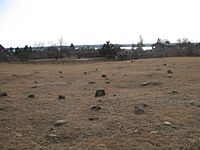- Montaukett
-
Montaukett Total population 500 enrolled Regions with significant populations United States (Long Island Languages Religion Related ethnic groups Shinnecock, Pequot, and Narragansett
The Montaukett (or Montauk) is an Algonquian-speaking Native American group native to the eastern end of Long Island, New York and one of the thirteen historical indigenous centers. They were related in language as well to Native American tribes who lived across Long Island Sound in what is now Connecticut and Rhode Island.
Native relics and ruins are still visible at Theodore Roosevelt County Park, just east of the village of Montauk, New York. Their language was an Algonquian Y-dialect, similar to their New England neighbors, the Pequot and the Narragansett. Native Americans living on Long Island eventually became identified by European settlers by the place name in which they lived, such as the Montauk and the Shinnecock, artificially identifying the peoples separately and erroneously into "tribes", although they all shared the same culture and language.[1] The Native Americans of the east end of the Island shared a common culture with each other and with other groups along most of the northern shore of what is now called Long Island Sound, while the west of Long Island were the culturally and linguistically distinct Lenape groups that lived in all of what is now New Jersey and in parts of what is now eastern Pennsylvania and the northern shore of Delaware.
The Montaukett derived great wealth from the wampompeag (or wampum) available on Long Island, but its value contributed to competition, attacks and their demise. Since it became desired for trade and payment by Native Americans and the English and Dutch colonial powers, the Montaukett were raided and made politically subject by more powerful New England tribes, who demanded tribute or just stole the wampum. Introduced infectious diseases, such as smallpox, to which they had no natural immunity, and intertribal warfare, combined for great population losses, similar to that suffered by other Native American groups.
In the late 17th century, Chief Wyandanch signed a treaty transferring much of the territory of Long Island to English settler Lion Gardiner. The Montaukett reportedly thought they were signing a treaty with the colonists for alliance and protection from the Narragansett tribe, rather than losing control of their land. This interpretation may also have been due to differing cultural concepts about land and its uses.[citation needed] According to legend, Chief Wyandanch was poisoned by tribesmen in retaliation for selling the land to the colonists.
Mohegan missionary and preacher, Samson Occom, formed the Brothertown group along with members of the neighboring Shinnecock band. They moved from Long Island to escape colonial encroachment, to Oneida County, New York. Later most of the people relocated to Wisconsin. Today they are part of the Brothertown Indians movement.
Many Montaukett remained in the area around Montauk, chiefly because the land was often considered inaccessible. At the end of the 19th century, the most notable Montaukett was Stephen Talkhouse (Stephen Taukus “Talkhouse” Pharaoh). He was known to walk 30 to 50 miles round-trip per day from Montauk to East Hampton or Sag Harbor. Various stones on his routes, part of the present-day Paumanok Path hiking trail, have been marked with this account. P.T. Barnum featured Pharaoh as "The Last King of the Montauks", despite his being neither a king nor the last Montaukett!
In 1879, an extension of the Long Island Rail Road reached Montauk. Arthur W. Benson began buying up land in the area with an eye to future development. In the court battles that ensued, the Montaukett lost their legal status and right to compensation.
About 500 members are currently listed on the rolls.
The tribe is related by historic language and culture to the federally recognized Shinnecock Indian Nation in neighboring Southampton.
Contents
See also
- Montauk land claim
Books
- John A. Strong, The Montaukett Indians of Eastern Long Island (Iroquois and Their Neighbors), New York: Heart of the Lakes Publishing, June 1998. (ISBN 0-8156-2883-8)
References
- ^ Strong, John A. We Are Still Here: The Algonquian Peoples of Long Island Today, 2nd edition. New York: Heart of the Lakes Publishing, June 1998. ISBN 978-1557871527
External links
- "Montaukett", Gurney's Quarter Website
Categories:- East Hampton (town), New York
- Native American tribes in New York
- Algonquian ethnonyms
Wikimedia Foundation. 2010.


